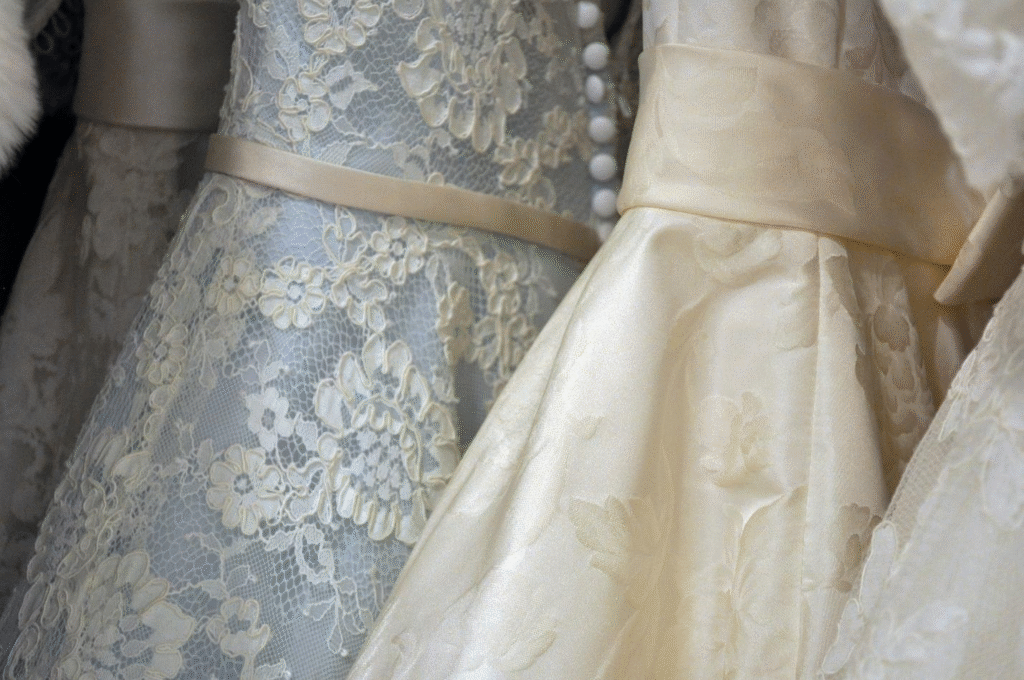Top Tips to Improve Your Sports Betting Skills
Top Tips to Improve Your Sports Betting Skills فهم الأسس العامة للمراهنات الرياضية تعد المراهنات الرياضية من الأنشطة الترفيهية التي تتطلب مزيجًا من الفهم والمعرفة والخبرة. إذا كنت ترغب في

Have you inherited a breathtaking wedding dress with delicate embroidery, and wonder how to keep it looking beautiful forever?
Or maybe your own wedding gown holds cherished memories you want to preserve. Embroidered wedding gowns are not only elegant and timeless, they’re also fragile and require special care. Whether it’s lace, floral threads, or beadwork, preserving the charm of these gowns starts with proper cleaning and storage.
From cleaning to long-term storage, every step matters when it comes to maintaining the quality and beauty of vintage embroidered gowns. These garments aren’t just clothing, they’re pieces of history, emotion, and artistry.
Embroidered wedding gowns are often made with delicate materials like silk, tulle, or lace and feature detailed threadwork, sequins, pearls, or even floral embroidery. These designs make the gown visually stunning but also more sensitive to damage from stains, moisture, and poor storage conditions.
Vintage embroidered gowns for women tend to be even more delicate due to their age. Fabrics naturally weaken over time, and improper handling can lead to permanent damage. That’s why learning how to clean and preserve them properly is essential if you want your gown to last for generations.
Before cleaning, inspect your gown carefully. Look for any visible stains, loose threads, missing beads, or areas where the embroidery may be coming apart. Vintage embroidered gowns often have hidden signs of wear that need to be addressed before washing or storing.
Check the label (if it still exists) for any cleaning instructions. If you’re unsure of the fabric or stitching material, it’s best to consult a textile expert or professional preservationist.
Never toss embroidered dressing gowns or wedding gowns into a regular washing machine. These garments require gentle hand-cleaning or professional dry cleaning. If you’re doing it at home, begin with a small spot test using a gentle detergent and cold distilled water.
To hand-clean, fill a clean bathtub or basin with cool water and a small amount of mild soap. Submerge the gown gently, using your hands to softly agitate the water without scrubbing. Focus on areas with sweat or light stains, like the underarms or hemline, but avoid heavy rubbing.
For embroidered evening gowns with intricate beadwork or floral embroidery, extra caution is necessary. Embellishments can become detached or discolored if handled roughly or exposed to harsh chemicals.
Once cleaned, rinse the gown thoroughly in cool distilled water to remove any soap residue. Do not wring or twist the fabric. Lay the gown flat on a clean white towel and gently press out excess water. Then transfer it to another dry towel or a mesh drying rack.
Let it air dry in a well-ventilated room away from direct sunlight, which can fade both fabric and thread colors. Never hang a wet embroidered wedding gown, as the weight can stretch and damage delicate fibers and embroidery.
Once dry, store your gown properly to preserve its quality. Avoid regular plastic garment bags, which can trap moisture and cause mildew or yellowing. Instead, wrap the gown in acid-free tissue paper and place it in a breathable, acid-free preservation box.
Fold the gown carefully, placing tissue between each layer to prevent creases. For extra protection, store the box in a cool, dry, and dark place, such as a closet or under a bed, never in a humid attic or basement.
If your embroidered dressing gowns or wedding dress includes accessories like veils or gloves, store them separately using the same method.
Inspect your preserved gown once a year. Air it out in a cool room for a few hours to prevent musty smells. Check for signs of yellowing, insect damage, or loose threads. Re-fold the gown differently to avoid permanent creases in the same spot.
For very old embroidered gowns for women’s that may already show wear or damage, consult a textile conservator for restoration options. Even small repairs can make a big difference in how your gown holds up over time.
Maintenance of couture gowns can be difficult. Some embroidered wedding gowns feature metallic threads or hand-stitched floral designs. These require even more delicate handling. Avoid using any products with bleach or brighteners, and always test a small, hidden section before applying any cleaning solution.
Floral embroidered gowns are particularly vulnerable to moisture and heat, which can warp the design or cause dyes to bleed. Keep these stored with extra tissue and check them more frequently for signs of aging.
If you’re unsure about cleaning your gown yourself, it’s worth taking it to a professional cleaner who specializes in bridal or vintage clothing. They use specialized techniques and equipment that are safer for delicate materials and complex embroidery.
When choosing a professional, ask about their experience with embroidered gowns for women and what preservation options they offer. Some cleaners will vacuum-seal your dress, though breathable boxing is usually a better long-term choice.
A beautifully preserved wedding gown can be passed down as a cherished heirloom. Whether it’s worn again or kept as a memory, your gown will tell a story that continues through the generations. Make sure to include notes about the gown’s history, fabric, and any special care it received. This adds sentimental and practical value for whoever receives it next.
Preserving embroidered wedding gowns takes patience and attention to detail, but the reward is timeless. From gentle hand cleaning to safe storage, each step helps ensure your gown remains as stunning as the day it was worn. Whether it’s a treasured heirloom or your own bridal memory, taking the time to care for embroidered gowns the right way will keep them beautiful for years to come.
For expert help or to learn more about gown preservation services, feel free to reach out at
+971 52 9666276 or support@sophiabognem.com. Your memories deserve to last forever. Also, if you are ready to invest in a good gown, Sophia Bognem is the way to go!
Steaming is safer than ironing, but should still be done with caution. Keep the steamer at a distance and avoid direct contact with embroidery or delicate fabrics.
Do not attempt to fix this at home. Take the gown to a professional tailor or textile conservator to avoid further damage.
Vacuum-sealing can damage delicate fabrics over time by compressing fibers. Use acid-free boxes and breathable materials instead.
Use a gentle mix of white vinegar and water for spot cleaning, but always test first. For severe discoloration, consult a professional.
Yes, if it’s been well preserved. Have it professionally cleaned again before wearing to freshen it up and check for any needed repairs.
Top Tips to Improve Your Sports Betting Skills فهم الأسس العامة للمراهنات الرياضية تعد المراهنات الرياضية من الأنشطة الترفيهية التي تتطلب مزيجًا من الفهم والمعرفة والخبرة. إذا كنت ترغب في

Have you ever wondered how runway trends from Paris, Milan, or New York make their way to the streets of Dubai and Abu Dhabi? The UAE’s fashion scene has evolved

Are you tired of trying on countless dresses in stores, only to leave empty-handed? Buying dresses online can be tricky, but with the right approach, you can find styles that

Are you searching for a gown that blends simplicity with elegance? Choosing the right simple gown design can make you stand out at any event while keeping a sophisticated charm.

Have you ever watched a celebrity glide across the red carpet and wondered how you could pull off that same dazzling look? Dressing to impress at an event isn’t just

Founded in 2016 and headquartered in Abu Dhabi, Sophia Bognem is a premier luxury couture house offering an ultra-personal, timeless fashion experience for women across the UAE. The house serves
WhatsApp us
